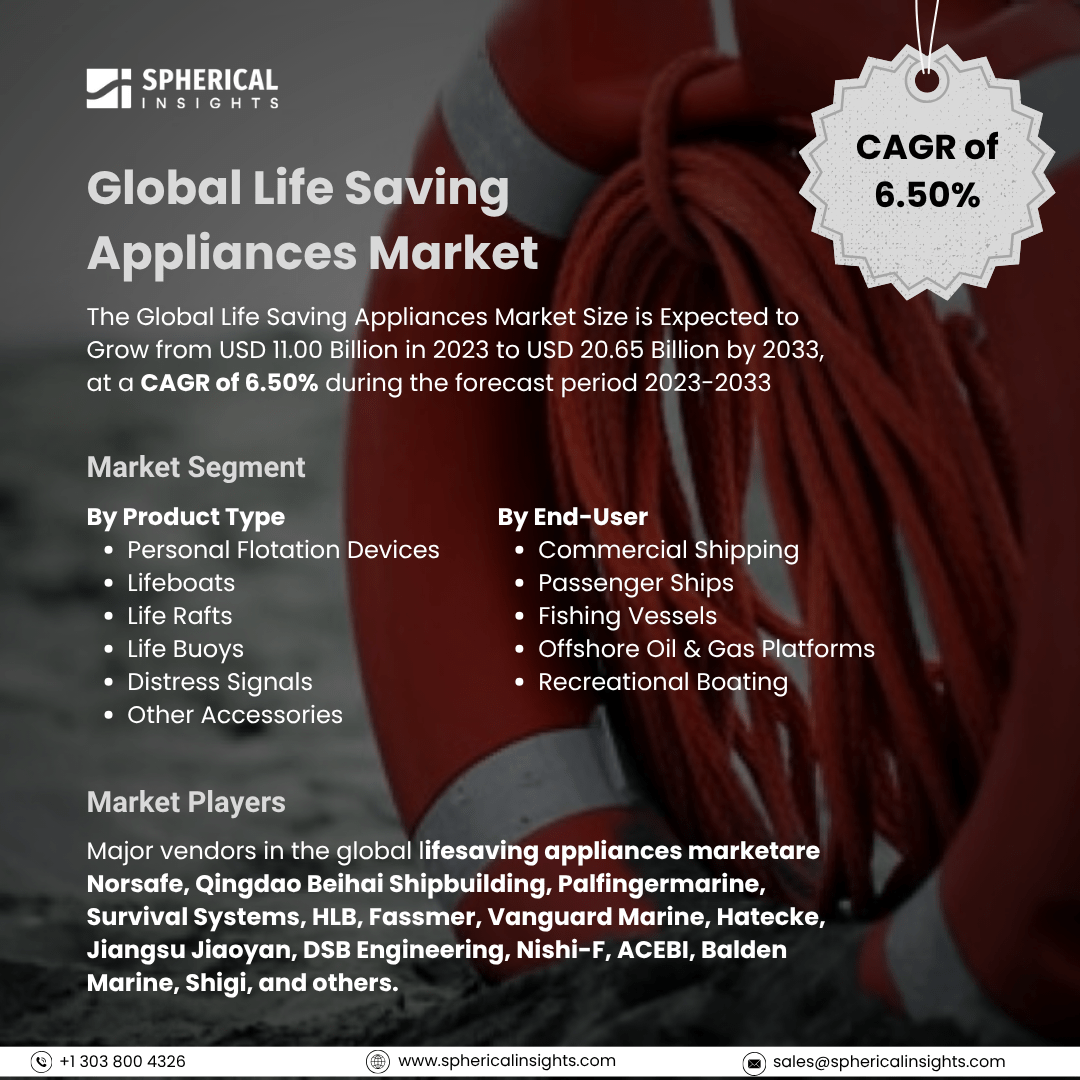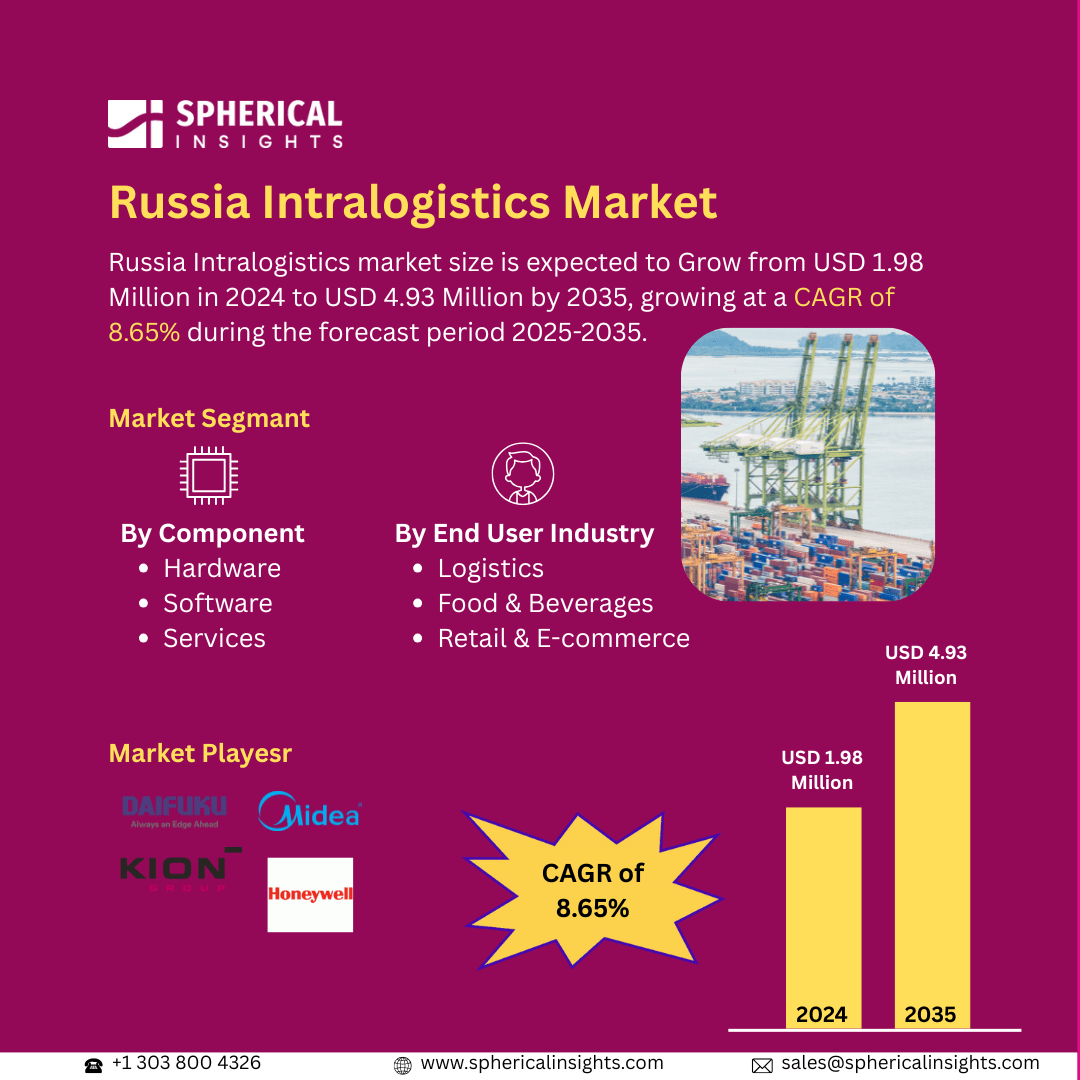Global Life Saving Appliances Market Size To Exceed USD 20.65 Billion by 2033
According to a research report published by Spherical Insights & Consulting, The Global Life Saving Appliances Market Size is Expected to Grow from USD 11.00 Billion in 2023 to USD 20.65 Billion by 2033, at a CAGR of 6.50% during the forecast period 2023-2033.
Browse 210 market data Tables and 45 Figures spread through 190 Pages and in-depth TOC on the Global Life Saving Appliances Market Size, Share, and COVID-19 Impact Analysis, By Product Type (Personal Flotation Devices (PFDs), Lifeboats, Life Rafts, Life Buoys, Distress Signals, and Other Accessories), By End-User (Commercial Shipping, Passenger Ships, Fishing Vessels, Offshore Oil & Gas Platforms, and Recreational Boating), and By Region (North America, Europe, Asia-Pacific, Latin America, Middle East, and Africa), Analysis and Forecast 2023 – 2033.
The global lifesaving appliances market encompasses the industry dedicated to the development, production, and distribution of equipment designed to protect human life during emergencies, particularly in maritime, aviation, and industrial contexts. These appliances include lifeboats, life rafts, life jackets, fire safety equipment, and other essential safety tools intended to ensure survival in critical situations. Furthermore, the global lifesaving appliances market is driven by stringent maritime safety regulations, rising seaborne trade, and increasing awareness of passenger safety. Growth in offshore oil and gas exploration, cruise tourism, and naval defense activities further fuels demand. Technological advancements in safety equipment and mandatory compliance with international safety standards significantly contribute to market expansion across commercial and military sectors. However, the global lifesaving appliances market faces restraining factors such as high manufacturing and maintenance costs, stringent regulatory approvals, limited awareness in developing regions, and supply chain disruptions affecting timely product availability.
The personal flotation devices (PFDS) segment accounted for the largest share in 2023 and is anticipated to grow at a significant CAGR during the forecast period.
On the basis of the product type, the global lifesaving appliances market is divided into personal flotation devices (PFDS), lifeboats, life rafts, life buoys, distress signals, and other accessories. Among these, the personal flotation devices (PFDS) segment accounted for the largest share in 2023 and is anticipated to grow at a significant CAGR during the forecast period. The segmental growth is attributed to mandatory safety regulations in maritime activities, increased recreational water sports, and rising awareness of drowning prevention. Continuous product innovations and government safety initiatives are expected to drive substantial growth in this segment during the forecast period.
The commercial shipping segment accounted for the largest share in 2023 and is anticipated to grow at a remarkable CAGR during the forecast period.
On the basis of the end-user, the global lifesaving appliances market is divided into commercial shipping, passenger ships, fishing vessels, offshore oil & gas platforms, and recreational boating. Among these, the commercial shipping segment accounted for the largest share in 2023 and is anticipated to grow at a remarkable CAGR during the forecast period. The segmental growth is attributed to increasing global trade, stringent maritime safety regulations, and the growing need for advanced life-saving equipment onboard vessels. Rising investments in fleet expansion and modernization, along with heightened focus on crew safety, are expected to propel this segment’s significant growth during the forecast period.
North America is projected to hold the largest share of the global lifesaving appliances market over the forecast period.
North America is projected to hold the largest share of the global lifesaving appliances market over the forecast period. The regional growth is attributed to its strong maritime industry, strict safety regulations, and high adoption of advanced safety technologies. The region benefits from significant investments in commercial and recreational marine sectors, as well as continuous innovation and enforcement of safety standards by regulatory authorities like the U.S. Coast Guard.
Asia Pacific is expected to grow at the fastest CAGR in the global lifesaving appliances market during the forecast period. The regional growth is attributed to expanding shipbuilding activities, increasing maritime trade, and rising investments in coastal safety infrastructure. Growing awareness about marine safety, supportive government regulations, and the rapid development of commercial and passenger shipping industries in countries like China, India, and South Korea further fuel market growth.
Company Profiling
Major vendors in the global lifesaving appliances market are Norsafe, Qingdao Beihai Shipbuilding, Palfingermarine, Survival Systems, HLB, Fassmer, Vanguard Marine, Hatecke, Jiangsu Jiaoyan, DSB Engineering, Nishi-F, ACEBI, Balden Marine, Shigi, and others.
Key Target Audience
- Market Players
- Investors
- End-users
- Government Authorities
- Consulting and Research Firm
- Venture capitalists
- Value-Added Resellers (VARs)
Market Segment
This study forecasts revenue at global, regional, and country levels from 2023 to 2033. Spherical Insights has segmented the global lifesaving appliances market based on the below-mentioned segments:
Global Life Saving Appliances Market, By Product Type
- Personal Flotation Devices (PFDs)
- Lifeboats
- Life Rafts
- Life Buoys
- Distress Signals
- Other Accessories
Global Life Saving Appliances Market, By End-User
- Commercial Shipping
- Passenger Ships
- Fishing Vessels
- Offshore Oil & Gas Platforms
- Recreational Boating
Global Life Saving Appliances Market, By Regional
- North America
- Europe
- Germany
- UK
- France
- Italy
- Spain
- Russia
- Rest of Europe
- Asia Pacific
- China
- Japan
- India
- South Korea
- Australia
- Rest of Asia Pacific
- South America
- Brazil
- Argentina
- Rest of South America
- Middle East & Africa
- UAE
- Saudi Arabia
- Qatar
- South Africa
- Rest of the Middle East & Africa



